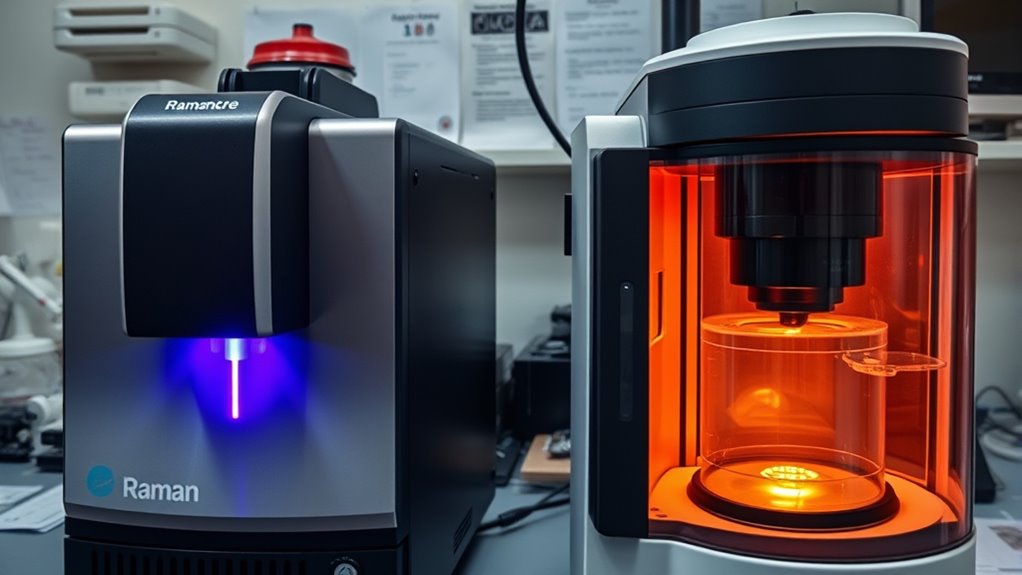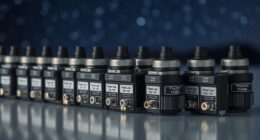When choosing between Raman and IR spectroscopy, consider your sample’s properties and preparation needs. Raman works well with delicate, complex, or moisture-sensitive samples since it requires minimal prep and can analyze solids, liquids, or gases directly. IR is more sensitive to specific functional groups, especially in well-prepared, homogeneous samples, but needs careful sample handling. Exploring their differences further helps you pick the right technique for your analysis.
Key Takeaways
- Use Raman for minimally invasive analysis of complex or delicate samples with little or no prep needed.
- Choose IR when analyzing well-prepared, homogeneous samples with strong dipole-active vibrations for higher sensitivity.
- Opt for Raman if fluorescence interference can be managed, especially with samples sensitive to chemical alteration.
- Prefer IR for detecting specific functional groups in solid, liquid, or gaseous samples with straightforward sample prep.
- Consider Raman’s sensitivity to laser heating and fluorescence, and IR’s limitations with opaque or scattering samples, when selecting the technique.

Spectroscopy techniques like Raman and infrared (IR) spectroscopy are essential tools for analyzing molecular structures, but they differ profoundly in how they detect vibrations. When choosing between them, you need to contemplate sample preparation challenges and instrument sensitivity considerations.
Raman spectroscopy often requires minimal sample prep because it can analyze solids, liquids, and gases directly, reducing the risk of contamination or degradation. In contrast, IR spectroscopy may demand more careful sample handling, especially if you’re working with solids. You might need to prepare pellets, KBr discs, or thin films, which can introduce impurities or alter the sample’s natural state. These steps can be time-consuming and might affect the accuracy of your results, so you should evaluate whether your sample can withstand such preparation without changing its molecular characteristics. Sample preparation considerations are crucial for obtaining reliable spectra in both techniques.
Raman needs minimal prep; IR may require pellets or thin films, risking contamination and altering samples.
Instrument sensitivity is another critical factor. Raman spectroscopy typically requires a highly sensitive detector because the scattered light signals are inherently weak. Modern Raman instruments often incorporate laser sources with high power and advanced detectors to improve sensitivity, enabling you to analyze even trace amounts of material. However, the technique can be susceptible to fluorescence interference, which can overshadow the Raman signal and complicate interpretation.
IR spectroscopy generally offers higher sensitivity for functional groups with strong dipole moments, making it suitable for detecting specific bonds in a molecule. Its instruments tend to be more straightforward and stable, often providing consistent results with less susceptibility to external interferences. Nevertheless, IR’s sensitivity can diminish when analyzing dilute samples or materials with weak IR-active vibrations, requiring you to optimize sample thickness and purity carefully.
When weighing your options, consider that Raman’s flexibility in sample preparation makes it ideal for complex or delicate samples that might degrade or be altered during traditional IR prep. Conversely, IR’s higher sensitivity for certain vibrational modes can be advantageous when analyzing compounds with strong dipole moments, especially in well-prepared, homogeneous samples.
Remember that laser-induced heating in Raman can sometimes pose a challenge for heat-sensitive materials, so you may need to adjust laser power or use cryogenic techniques. Meanwhile, IR instruments are generally less prone to sample damage but may struggle with highly scattering or opaque samples. Additionally, advances in detector technology continue to improve instrument sensitivity, making Raman spectroscopy more accessible for a broader range of applications.
Frequently Asked Questions
Can Raman and IR Be Used Together for Comprehensive Analysis?
You can definitely use Raman and IR spectroscopy together for thorough analysis. These complementary techniques provide integrated analysis by revealing different molecular vibrations, which helps you identify complex samples more accurately.
Combining them allows you to overcome limitations of each method and gain a fuller understanding of your material’s structure. Using both techniques together enhances your ability to analyze samples in various contexts, ensuring more reliable and detailed results.
How Do Sample Preparation Requirements Differ Between Raman and IR?
Imagine your sample as a delicate dance partner—you need gentle handling. For IR spectroscopy, you often prepare thin films or KBr pellets, requiring meticulous sample handling to avoid contamination.
Raman spectroscopy, however, usually involves minimal sample prep, making contamination control easier.
Your goal is to keep the sample pristine and free from external influences, ensuring accurate results while minimizing preparation steps and preserving sample integrity.
Are There Specific Materials Better Suited for Raman or IR?
You should consider the material compatibility and instrument sensitivity when choosing between Raman and IR spectroscopy.
For example, Raman works better with materials like plastics and biological tissues, which scatter light effectively, and it’s less affected by water.
IR is ideal for compounds with strong absorption bands, like organic molecules and certain minerals.
Your choice depends on the sample’s nature and the sensitivity needed for accurate detection.
What Are the Cost Differences Between Raman and IR Spectroscopy?
When comparing cost differences between Raman and IR spectroscopy, you’ll find that instrument pricing varies based on features and capabilities.
Generally, Raman spectrometers tend to have higher initial costs due to advanced laser components, while IR instruments are more affordable and simpler to operate.
However, consider ongoing expenses like maintenance and consumables, as these can influence your overall cost comparison.
Your choice depends on your specific analysis needs and budget constraints.
How Does the Resolution Compare Between Raman and IR Techniques?
Imagine spectral detail as your map, guiding your discovery. Raman spectroscopy often offers higher resolution with sharper peaks, revealing subtle differences in molecular vibrations.
Infrared, while reliable, sometimes provides broader features, making it less precise. Your choice depends on instrument precision and the level of detail you need.
With Raman, you get crisper, more detailed spectra, making it ideal when high resolution is critical for accurate analysis.
Conclusion
When choosing between Raman and IR spectroscopy, consider your sample’s nature and the information you need. For instance, if you’re analyzing a complex biological tissue, Raman can provide detailed molecular insights without extensive sample prep. Imagine studying a pharmaceutical compound—Raman’s non-destructive nature permits you to examine it directly. Ultimately, understanding each method’s strengths guarantees you select the right one, making your analysis more efficient and accurate. Both techniques are powerful tools in your scientific toolkit.









